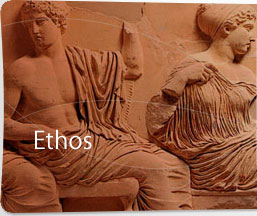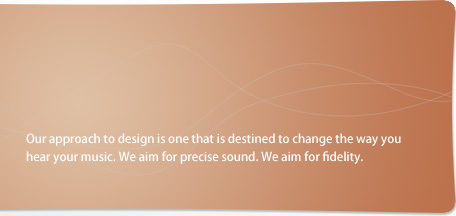Ethos The fundamental character or spirit of our approach to design; the underlying sentiment that informs our beliefs, customs, practices and our dominant assumptions
|
White Paper
“The typical loudspeaker product
is designed to make money and not necessarily to provide accurate sound
reproduction. Since customers prefer small, unobtrusive speakers and
judge sound quality by the amount of bass that they hear and by high
frequencies they had not noticed before, there is a staggering number of
essentially identical designs on the market that meet these requirements
at different price points. No wonder then that there is a generic
loudspeaker sound and that you can always tell whether something you
hear originates from a speaker or a live source. The marketing
departments of the different speaker manufacturers are busy to point out
differentiating features and breakthrough inventions when it comes to
the highest price points, but in reality box loudspeaker design has come
to a dead end and all you will hear are slight variations on the same
theme. The fundamental problems of box re-radiation and non-flat power
response in a room are at best only partially solved by these designs. “
“Sound reproduction is about creating an auditory illusion. When the
recorded sound is of real instruments or voices there is a familiar,
live reference in our auditory memory. The illusion of hearing a
realistic reproduction is destroyed by distortion that is added anywhere
in the signal chain from microphone to loudspeaker, but the speaker is
by far the biggest culprit. Every designer focuses on the on-axis
frequency response as if it were the all determining distortion
parameter. Sometimes great attention is paid to the phase response in an
attempt to preserve waveform fidelity, which at best can only be
achieved for a single listening point in space. Ignored usually, though
of much greater importance, is resonance in drivers and cabinets and the
slow release of stored energy that goes with it. Furthermore, the
uniformity and flatness of the off-axis frequency response which we hear
via room reverberation and reflections is rarely a design goal. You can
check the naturalness of the timbre by listening from another room. Does
it sound like a loudspeaker is playing? The imbalance in the speaker's
power response between low and high frequencies gives it away.”
Quoted from Sigfried Linkwitz, noted
speaker designer Our Design Objectives 1 Low distortion - To achieve waveform fidelity.
Sounds exhibit waveforms. Distortion comes from waveforms that deviate
from the output of the source; ie. amplifier power being poorly
converted to sound power. A low distortion speaker driver typically has
a large magnet (expensive) and a large capacity for movement. Our bass
driver has a long throw (1" peak to peak), which is abetted by its
extended voice coil. The magnet that drives the cone is huge, about the
same size of the cone. This means it has a terrific ability to respond
with dynamic weight, but also to remain linear, that is, to reproduce
from the softest to the loudest sound without running out of headroom.
Some designs that are good in many areas sound lifeless because they
fall short in this very important requirement. Now, take a piece of
piano, and hear the attack, the startle factor. 2 Avoiding Resonance
Most speaker boxes use resonance to make bass (ported bass refex). That
sells more boxes (can you blame them?)
Here is the problem: A sound has a beginning and an end.
Resonance cannot start quickly or stop quickly. Bass resonance is heard
as a muddy, boomy one-note sound. Resonance causes all bass notes to
seem the same, they lose pitch. Can you tell the bass instrument has
four strings? Resonance also causes rhythm to become smeared. All music
requires timing. Rhythm is timing. Weakening rhythm is taking away
musical value, the feel, the connectedness, the beat of the music.
3 Avoid box re-radiation
Once the sound waves have left the speaker and are on the way to you all
is fine, right? Not quite. The energy whiplash of the cone sets up
vibrations in the box. The vibrations are mechanical and also in the air
in the box. These are slowly released over time as soundwaves that make
their way to you to arrive just slightly out of sync with the ones that
are desired. The result? A smear of musical detail and a reminder that
you are listening to a “box”. We overbuild our boxes for rigidity to
avoid vibration. We manage the flow of sound in the box to avoid
re-radiation. |
|
|
|
|
|
4 Improving the most important area - the mid range, by using a new, wide range tweeter
We use new latest in high tech drive units. These are arguably the best
in the world. Take the new
1" dual concentric (ring radiator) tweeter. This tweeter is very
special. It reaches down to 2kHz, which is far lower in frequency than
tweeters normally do. Most tweeters only go down to around 4kHz, which
means the woofer has to reach all the way up to that frequency. This
leads to "stressed and ragged performance in the range 2kHz to 4kHz.
Hear midrange detail previously thought impossible. Violins and trumpets
will emerge with a sweetness and detail that is very special. It also
uses a "waveguide" to increase its dispersion (it also has the effect of
changing the driver's first resonance above 44kHz). An instrument, take
for example a violin, contains a fundamental note, and overtones that
are related in a specific manner. You will hear the coherence between
the different frequencies as a tunefulness, an ability to hear the
melody. Prepare yourself for a major improvement in the harmonic balance
in the middle and high registers on these new drive units.
5 Improving Bass Musicality
The newly released bass unit is without compromise.
The multi-faceted 5.5" composite carbon-fiber cone midrange-woofer is
damped by a butyl surround and housed in a cast-aluminum/magnesium
frame. Quiet? Some of the materials commonly marketed as "high
tech" like metal, aluminum, titanium will extend the frequency range,
but also ring with a "metallicness" Our materials are beyond those for
accuracy because ours will instantly absorb the spent energy after the
sound has been produced, leading to perfect inter-transient silence. Now
you will hear the more subtle details. You will also realize that
listening fatigue is non existent. 5 Achieving a wide frequency
range
The range of sounds we desire is to wide for one speaker unit to
produce. Therein lies a problem. The range has to be split between
different drivers (woofer, mid, tweeter), and the resultant split puts
them slightly out of sync.
The timing error is described as a phase error. This causes many
problems. Human beings use timing of sounds to tell the spatial
positioning of sounds (that’s why you have two ears). Phase error
reduces the accuracy of the reproduced sound’s position. Every
instrument on a musical stage has a position. If you are in the third
row you will be able to point at the instruments. With most speakers you
cannot. Our speaker has the lowest phase error known in speaker design
(for the technical, we use a first order crossover network). It means
you have to sacrifice some bass output, because our speaker is a two-way
design. In return, you may hear the magic of soundstaging of all but the
very best speakers, at any price.
Another problem caused by phase error is poor attack
6 Bringing it all together – about musical reproduction
Music is built on three
ingredients; Melody, dynamics, rhythm. All the tiny shadings of these
components make up the vocabulary of the music’s communication.
In English the words we
form are made with 26 characters of the alphabet. How many words can we
form, how much emotion can we communicate with words?
Music has an infinitely
greater amount of vocabulary, because there are thousands of thousands
of combinations of notes(melody), loudnesses (dynamics), and time
patterns. Thus music can express emotion better than language, and is
possibly the greatest art form of all.
This is the core of our
offering to you – a loudspeaker that is more capable in communication.
Not more sound. Sound isn’t music. |
|


